(click on photos to enlarge image)
FULL LIST OF MARKS USED BY BROTHERS HENNEBERG COMPANY
Early marks for silver-plated hollow ware (galvanic silver deposition
on brass or rolled silver deposition on copper).

|
N°
|
PERIOD, MARK & COMMENT
|
|
1
|
c.1856 - c.1870


The earliest mark of Bros. Henneberg company for silver-plated hollow ware items produced with galvanic silver deposition on brass base contains the names of the owners "HENNEBERG & CZAJKOWSKI" (in Polish), as well as the factory's location "WARSZAWA" (WARSAW in English), set in the oval. Additionally, there is a word in French "PLAQUE" (PLATE) and the "N" letter inside a cartouche of fancy shape, stating the normal thickness of the deposited silver layer (see below these marks in better condition). These two symbols were used originally by two famous Polish firms, Fraget and Norblin, for marking the galvanic process of silver deposition. Rare.
|
|
2
|
c.1870 - c.1874




The next mark of Bros. Henneberg firm for galvanic silver deposition on brass base contains instead of the word "HENNEBERG" the inscription  (a short form for BRACIA HENNEBERG, in English BROS. HENNEBERG). Often the inscription " (a short form for BRACIA HENNEBERG, in English BROS. HENNEBERG). Often the inscription " " is badly printed. Other parts of the mark, the inscription "& CZAJKOWSKI WARSZAWA", the word in French "PLAQUE" (PLATE) and the "N" letter inside the cartouche of fancy shape, are similar to the previous mark. Rare. " is badly printed. Other parts of the mark, the inscription "& CZAJKOWSKI WARSZAWA", the word in French "PLAQUE" (PLATE) and the "N" letter inside the cartouche of fancy shape, are similar to the previous mark. Rare.
|
|
3
|
c.1870 - c.1874
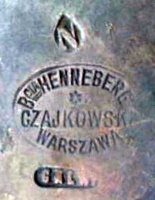





This mark for galvanic silver deposition on brass base from the first view looks similar to the previous one, but it contains numerous changes. First, it is made with a larger font. Second, instead of the English symbol "&", it uses the corresponding Polish symbol "i" (means "and" in Polish). Third, a new image of 6-petal rosette is put in the centre of the oval. The size of the oval is about 7.1 mm x 10.9 mm. Fourth, the Polish expression "GALW:" is used instead of the French word "PLAQUE". "GALW:" is the shortening of GALWANIZACJA (GALVANIC PROCESS in English, which means silver deposition at high voltage applied), used originally by the famous Polish firms, Fraget and Norblin. Fifth, the letter "N" is given now in a rhombus. Rather common.
|
|
4
|
c.1870 - c.1874



This mark is for silver-plated hollow ware items produced with rolled-silver deposition on copper (soldering of a thin sheet of silver to a red-heated copper plate with subsequent rolling). It is similar to the Mark No.3, given above, but instead of two secondary marks (inscription "GALW:" and the letter "N" is given in a rhombus) it uses the inscription "PLATER", made with a sans serif font and set in a cartouche of rectangular form. Rare.
|
|
5
|
c.1874


This mark for galvanic silver deposition on brass base was used immediately after one of the owners, Michal Czajkowski (in English Michael Tchaikovsky), left the company. Therefore, this mark omits his name and also the image of the six-petal rosette. Extremely rare.
|
Marks for silver-plated hollow ware
(galvanic silver deposition on brass or rolled silver deposition on copper).
Main inscription: B.HENNEBERG WARSZAWA.
|
N°
|
PERIOD, MARK & COMMENT
|
|
6
|
c.1874 - 1883


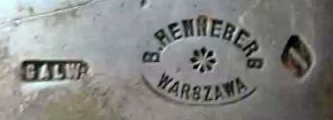




The next mark for galvanic silver deposition on brass base, issued after the departure of Mr.Czajkowski, contains a new inscription "B. HENNEBERG" (a short form of Bracia HENNEBERG) together with information on factory location (inscription "WARSZAWA") in the oval with a new image of 8-petal rosette in the centre. The secondary marks (inscription "GALW", made with a sans serif font, and the "N" letter in rhombus) are similar to those used in the previous two marks. Interestingly, at the end of the inscription "GALW" either a dot or a colon are used, in the proportion c.15% and c.85% of all the cases, respectively. I suppose that these two signs refer to different amounts of deposited silver. Rather common.
|
|
7
|
c.1874 - c.1883

This mark is for silver-plated hollow ware items produced with rolled silver deposition on copper (soldering of a thin sheet of silver to a red-heated copper plate with subsequent rolling). It is similar to the Mark No.6 discussed above, but instead of two secondary marks (inscription "GALW", made with a san serif font, and the "N" letter in rhombus) it uses the inscription "PLATER", made with a sans serif font and set in a cartouche of rectangular form. Rare.
|
|
8
|
c.1883 - c.1897





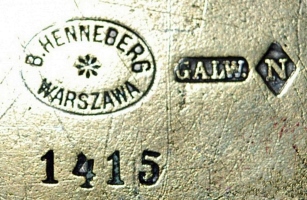



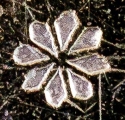


 Starting from c.1883, the slightly changed mark was used to designate the galvanic silver deposition on brass. First, the inscription "GALW" is made with a serif font. Second, now at the end of the inscription "GALW" either one dot is present (in 75% of all the cases) or no dots are used at all (in 25% of all the cases).
Again, these two designations are probably referring to different amounts of deposited silver. From around 1896 this mark contains also the model number, three or four digits given below the oval. The size of the oval is about 8.3 mm x 11.0 mm. A widespread mark.
|
|
9
|
c.1883 - c.1894

Next mark is for silver-plated hollow ware items produced with rolled silver deposition on copper (soldering of a thin sheet of silver to a red-heated copper plate with subsequent rolling).
It is similar to the Mark No.8, given above, but instead of two secondary marks (inscription "GALW", made with a serif font, and the "N" letter in rhombus) it uses the inscription "PLATER", made with a sans serif font and set in a cartouche of rectangular form. Rare.
|
|
10
|
c.1894 - c.1898








In around 1894, the Bros. Henneberg company, in order to raise the durability of silver coating deposited on the most exquisite and hence expensive items, decided to increase the amount of silver used for deposition. For this reason a new mark was developed, which was used for high-quality silvering designation. It contained the two previous
inscriptions "B. HENNEBERG" and "WARSZAWA" but instead of the 8-petal rosette used a 7-ray star. It should be emphasized that the old mark with 8-petal rosette was not crossed off from the list of active marks but kept for middle-quality silver-plated hollow ware items (see below). From 1896 this new mark always contained also the model number, three or four digits below the oval. From c.1897 it was used without secondary marks like "GALW." and the letter "N" in a rhombus. The size of the oval is about 7.0 mm x 10.5 mm. This mark was applied for a short time and therefore it is rather rare.
|
|
11
|
c.1894 - c.1898
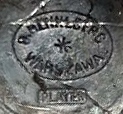


This mark is for silver-plated hollow ware items produced with rolled silver deposition on copper (soldering of a thin sheet of silver to a red-heated copper plate with subsequent rolling). It is similar to the Mark No.10, given above, but lacks secondary marks like "GALW." and the letter "N" in a rhombus. Instead it contains additionally the inscription "PLATER", made with a sans serif font and set in a cartouche of rectangular form.
From 1896 this mark contained also the model number, three or four digits below the oval. Rare.
|
|
12
|
c.1898 - c.1939
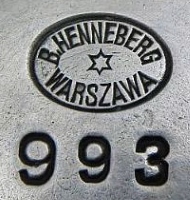


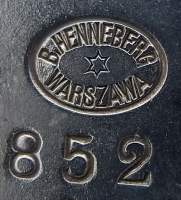










Starting from c.1898, the Bros. Henneberg company applied a new mark for high-quality galvanic silver deposition which instead of the fancy 7-ray star used the traditional 6-pointed Star of David. In 2013, one of us (D.N.) was lucky to study a rare silver-plated object, which belonged to Warsaw Museum. This object was marked with 6-pointed Star of David and additionally with the logo of famous HOTEL BRISTOL in Warsaw, see accompanying photos. As this hotel was opened in 1901 and usually the hotel silver is ordered before the opening of the hotel, then the proposed date (1898) of the issue of discussed mark agrees with the opening date of Hotel Bristol.
It should be emphasized that this new mark was well protected against possible forgery, as it had a small secret which we are reporting now for the first time. The letter "G" in the inscription "HENNEBERG" was provided with a characteristic tail (contrary to the letter "G" in the word HENNEBERG for middle-quality silver plate, issued after 1898, see below). The tail is visible only under significant magnification (see corresponding photos). This remarkable peculiarity made (and still makes today!) the possible fake of this mark rather difficult (see examples of Henneberg mark forgery given below). This mark contained also the model number, three or four digits below the oval. The size of the oval varies between 5.0 mm x 6.7 mm and 5.4 mm x 7.7 mm. A widespread mark.
|
|
13
|
c.1897 - c.1939






The mark for middle-quality galvanic silver deposition. It contains the two inscriptions "B.HENNEBERG" and "WARSZAWA" in the oval and the 8-petal rosette in the centre. Contrary to the mark for high-quality galvanic silver deposition, the letter "G" in the inscription "HENNEBERG" doesn't possess any tail (see accompanying photos). The size of the oval is about 7.0 mm x 10.7 mm. This mark contains also the model number, three or four digits given below the oval. A widespread mark.
|
|
14
|
c.1898 - c.1915



The mark for low-quality galvanic silver deposition. Like the previous mark No.13 it contains two inscriptions "B.HENNEBERG" and "WARSZAWA" in the oval, but instead of the 8-petal rosette it keeps the centre of the oval empty. The letter "G" in the inscription "HENNEBERG" sometimes possesses a tail, sometimes not (see accompanying photos). This mark contains also the model number, three or four digits given below the oval. A rather rare mark.
|
|
15
|
c.1898 - c.1915

This mark is for silver-plated hollow ware items produced with rolled silver deposition on copper (soldering of a thin sheet of silver to a red-heated copper plate with subsequent rolling). It is similar to the Mark No.13, given above, but contains additionally the inscription "PLATER", made with a sans serif font and set in a cartouche of rectangular form. Rare.
|
Marks for silver-plated flatware
(galvanic silver deposition on brass).
Main inscription: BRACIA HENNEBERG WARSZAWA.
|
N°
|
PERIOD, MARK & COMMENT
|
|
16
|
c.1883 - c.1896


The earliest known mark for the flatware items, produced with galvanic silver deposition on the surface of brass base, consists of the inscription in Polish "BRACIA HENNEBERG WARSZAWA" (in English "BROTHERS HENNEBERG WARSAW"), and two secondary marks: the inscription "GALW." with a dot at the end made with serif font and the "N" letter in rhombus. These secondary marks are similar to those used in the mark No.8. Rather rare.
|
|
17
|
c.1896 - c.1915


The next mark for the flatware items, produced with galvanic silver deposition on the surface of brass base, consists of the inscription in Polish "BRACIA HENNEBERG" (in English "BROTHERS HENNEBERG"), set in oval or rectangle without any secondary marks. This mark possesses also the model number, three or four digits given below the oval. Rather rare.
|
Marks for silver-plated hollow ware items produced with galvanic
silver deposition on tin-containing base, fabricated by casting.
Main inscription: BR: HENNEBERG w WARSZAWIE
or BR: HENNEBERG W WARSZAWIE.
|
N°
|
PERIOD, MARK & COMMENT
|
|
18
|
c.1874 - c.1883




The earliest mark for silver-plated hollow ware items made of tin-containing base metal consists of an oval with the inscription in Polish "BR: HENNEBERG w WARSZAWIE"( in English "Bros: HENNEBERG in WARSAW"), where the low case letter "w" is set between the two words, and possesses two secondary marks: the inscription "GALW:" (with a colon at the end) made with sans serif font, and the "N" letter in rhombus. These secondary marks are similar to those used in the mark No.6. Rare.
|
|
19
|
c.1883 - c.1897






The next mark for silver-plated hollow ware items made of tin-containing base metal differs from the previous mark No.18 by one of its secondary marks, namely, the inscription "GALW." with one (!) dot at the end made with serif font. From around 1896 this mark probably contains the model number, three or four digits given below the oval. I don't have such a mark in my collection.
One of my recent findings carries the date 1889, which confirms the dating of this mark, see the photo attached. The size of the oval is about 6.0 mm x 7.9 mm. A widespread mark.
|
|
20
|
c.1897 - c.1915
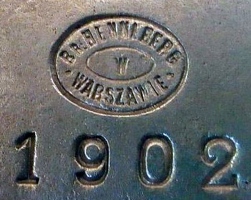
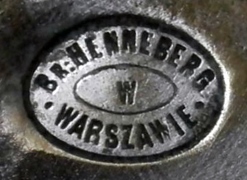
The next modification of the mark for silver-plated hollow ware items made of tin-containing base metal contains no secondary marks. This mark consists of an oval with the inscription in Polish"BR: HENNEBERG W WARSZAWIE", where the letter "W" between the two words is a capital one. In addition, the letter "W" is set inside the small internal oval and the inscription "WARSZAWIE" stands out with two dots (see accompanying photos). There is also the model number, three or four digits given below the oval. This mark was mainly used by Bros. Henneberg division in Wola (see below). Rare.
|
Marks for silver-plated items with brass base, fabricated by punching.

|
N°
|
PERIOD, MARK & COMMENT
|
|
21
|
c.1883 - c.1897




The first known mark for the items, produced by galvanic silver deposition on brass base made by punching, is similar to Mark No.19. However, instead of the inscription "BR: HENNEBERG w WARSZAWIE", another inscription
 is used, where the capital "R" letter (the second letter in the inscription) of smaller font size is used as a superscript without any dot or colon. Additionally, the secondary mark "GALW" made with serif font is used without any dot or colon at the end (see corresponding photos). From around 1896 this mark contains the model number, three or four digits given below the oval. Very rare. is used, where the capital "R" letter (the second letter in the inscription) of smaller font size is used as a superscript without any dot or colon. Additionally, the secondary mark "GALW" made with serif font is used without any dot or colon at the end (see corresponding photos). From around 1896 this mark contains the model number, three or four digits given below the oval. Very rare.
|
|
22
|
c.1897 - c.1939




The following mark for silver-plated items produced by galvanic silver deposition on brass base, made by punching, is similar to mark No.21. However, the letter "W" in the centre of the oval is the capital one and the secondary marks are absent. Common.
|
Marks for silver-plated items produced
by galvanic silver deposition on brass base, fabricated
by combined techniques (casting plus punching).
Main inscription: BR. HENNEBERG WARSZAWA.
|
N°
|
PERIOD, MARK & COMMENT
|
|
23
|
c.1883 - c.1897

The earliest known mark for the items, produced by galvanic silver deposition on base, which is prepared by combined techniques, is similar to Mark No.8. It possesses a slightly modified inscription in Polish "BR. HENNEBERG WARSZAWA" (instead of "B. HENNEBERG WARSZAWA"), set in an oval together with 8-petal rosette in centre, and two secondary marks: the inscription "GALW." made with a serif font with a dot at the end and the "N" letter in rhombus. From c.1896 this mark includes the model number, three or four digits given below the oval. Rare.
|
|
24
|
c.1897 - c.1915


The next mark for the silver-plated items, produced by galvanic silver deposition on brass base, which is made by combined techniques, is similar to Mark No.23, but the secondary marks, the "GALW." inscription and the "N" letter in rhombus, are absent. Rare.
|
Marks for Wola branch of Bros. Henneberg foundry.
Main sign: 5-petal crown.
|
N°
|
PERIOD, MARK & COMMENT
|
|
25
|
Wola Factory Absorption (WFA) year, sometimes between c.1897 and c.1900, when Wola Factory (in Polish Fabryka Wolska) was absorbed by Bros. Henneberg foundry.


A mark issued by Wola Factory with the inscription "FABRYKA WOLSKA POD WARSZAWA" (in English WOLA FACTORY NEAR WARSAW), used from 1885 [References 1], is over-printed with the Bros. Henneberg Mark No.13 (see additionally a photo of corresponding Wola Factory mark). As we don't know when exactly the Wola Factory was absorbed by Bros.Henneberg, we will name this year as WFA year.
|
|
26
|
WFA year - c.1915





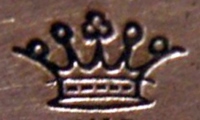

The main mark for high-quality silver deposition for Wola branch is similar to the one for Bros.Henneberg company (Mark No.12). It contains the inscription "B.HENNEBERG WARSZAWA" in the oval with the image of a 6-pointed Star of David in the centre. The letter "G" in the inscription "HENNEBERG" is made with a characteristic tail, which makes difficult the possible forgery. Below the oval there is the model number of three or four digits. Above the oval, another secondary mark is applied, namely, a remarkable five-petal crown, used earlier in the marks of Wola Factory [References 1]), see accompanying photos. Some marks for high-quality silver deposition contain also the oval with the inscription "PATENT 9205", which probably refers to the use of the Wola crown in this concrete mark of Bros. Henneberg foundry (see attached the sketch of the patent inscription taken from [References 2]). Together with this main mark for high-quality silver deposition, a secondary mark is applied, namely, a remarkable five-petal crown, used earlier in the marks of Wola Factory [References 1], see accompanying photos. Finally, besides the main mark, there is often an additional mysterious Russian inscription  is certainly the abbreviation of
is certainly the abbreviation of (Department of Trade and Manufacture), (Department of Trade and Manufacture),  probably means
probably means  (in English, "Paid"), signifying that the tax (probably, the export duty) was paid to the State Department of Trade and Manufacture, receipt No.1984. Rare.
(in English, "Paid"), signifying that the tax (probably, the export duty) was paid to the State Department of Trade and Manufacture, receipt No.1984. Rare.
|
|
27
|
WFA year - c.1915






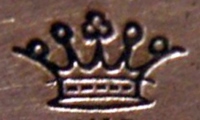




The main mark for middle-quality silver deposition for Wola branch is similar to the one for Bros. Henneberg company (Mark No.13). It contains the inscription "B.HENNEBERG WARSZAWA" in the oval with the image of 8-petal rosette in the centre. The letter "G" in the inscription "HENNEBERG" is made without a characteristic tale, see above. Below the oval is the model number, three or four digits given below the oval.
Above the oval, another secondary mark is applied, namely, a remarkable five-petal crown, used earlier in the marks of Wola Factory [References 1], see accompanying photos. Some marks for middle-quality silver deposition contain also the oval with the inscription "PATENT 7831", which probably refers to the use of the Wola crown in this concrete mark of Bros. Henneberg foundry. Finally, besides the main mark there is often an additional mysterious Russian inscription  1984 (or 1984 (or  13714"). 13714").  is certainly the abbreviation of
is certainly the abbreviation of (Department of Trade and Manufacture), (Department of Trade and Manufacture),  probably means probably means (in English, "Paid"), signifying that the tax (probably, the export duty) was paid to the State Department of Trade and Manufacture, receipt No.1984 (or No 13714).
Very recently, I have found a similar "crown" mark with the inscription (in English, "Paid"), signifying that the tax (probably, the export duty) was paid to the State Department of Trade and Manufacture, receipt No.1984 (or No 13714).
Very recently, I have found a similar "crown" mark with the inscription which means
"Sent to Manufacture Department". As in 1900 the Department of Trade and Manufacture was transferred into the Department of Manufacture, this latest finding justifies the above-made supposition concerning which means
"Sent to Manufacture Department". As in 1900 the Department of Trade and Manufacture was transferred into the Department of Manufacture, this latest finding justifies the above-made supposition concerning  . It also means this mark was used after 1900, while
those with . It also means this mark was used after 1900, while
those with
 - before 1900. This explains why we correlate the WFA year with the period between 1897 and 1900. Rare.
- before 1900. This explains why we correlate the WFA year with the period between 1897 and 1900. Rare.
|
|
28
|
WFA year - c.1915

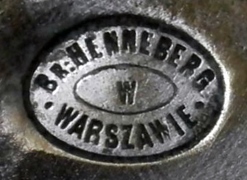




The main mark for silver-plated hollow ware items made of tin-containing base metal for the Wola branch is very similar to the one for Bros. Henneberg company (Mark No.20). This mark consists of an oval with
the inscription in Polish "BR: HENNEBERG W WARSZAWIE",
where the letter "W"between two words is a capital letter. In addition, the letter "W" is put inside the small internal oval and the inscription "WARSZAWIE" stands out with two dots (see accompanying photos). Below the oval is the model number, three or four digits given below the oval.
Above the oval with the inscriptions, another secondary mark is applied, namely, a remarkable five-petal crown, used earlier in marks of the Wola Factory [References 1], see accompanying photos. Finally, besides the main mark there is often an additional mysterious Russian inscription
 27070 . 27070 .  is certainly the abbreviation of
is certainly the abbreviation of  (Department of Trade and Manufacture),
(Department of Trade and Manufacture),  probably means probably means  (in English, "Paid"), signifying that the tax (probably, the export duty) was paid to the State Department of Trade and Manufacture, receipt No.27070. Rare.
(in English, "Paid"), signifying that the tax (probably, the export duty) was paid to the State Department of Trade and Manufacture, receipt No.27070. Rare.
|
Jubilee marks for silver-plated hollow ware items produced
by galvanic silver deposition on nickel silver base metal
(in Polish "Bialy Metal" or BM, which means White Metal).
Main sign: BH oval.
|
N°
|
PERIOD, MARK & COMMENT
|
|
29
|
c.1906





This mark is similar to the Mark No.12 for high-quality galvanic silver deposition on brass base, but it possesses two additional secondary marks: designation of nickel silver base metal BM (Bialy Metal, which means white metal) and a kind of coat of arms, with 5 stars, a balance, a bee image and two palm branches. This coat of arms is similar to the French silver-plate mark, used by the company Charles Christofle [References 3] (see the corresponding photo). However, instead of Charles Christofle initials CC, it uses two letters BH, which of course refer to Bros. Henneberg. Probably, this mark was issued to celebrate the 50 year jubilee of the factory. Rare.
|
|
30
|
c.1906





This mark is similar to the Mark No.13 for middle-quality galvanic silver deposition on brass base, but it possesses two additional secondary marks: designation of nickel silver base metal BM ( Bialy Metal, which means white metal) and a kind of coat of arms with 5 stars, a balance, a bee image and two palm branches. This coat of arms is similar to the French silver-plate mark, used by the company Charles Christofle [Reference 3] (see the corresponding photo). However, instead of Charles Christofle initials CC, it uses two letters BH, which of course refer to Bros. Henneberg. Probably, this mark was issued to celebrate the 50 year jubilee of the factory. Rare.
|
|
31
|
c.1906
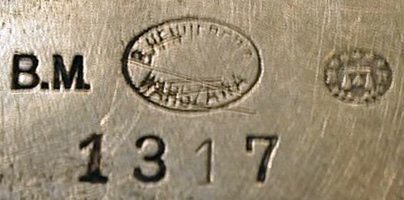




This mark is similar to the Mark No.14 for low-quality galvanic silver deposition on brass base, but it possesses two additional secondary marks: designation of nickel silver base metal BM (Bialy Metal, which means white metal) and a kind of coat of arms with 5 stars, a balance, a bee image and two palm branches. This coat of arms is similar to the French silver-plate mark, used by the company Charles Christofle [Reference 3] (see the corresponding photo). However, instead of Charles Christofle initials CC, it uses two letters BH, which of course refer to Bros. Henneberg. Probably, this mark was issued to celebrate the 50 year jubilee of the factory. Rare.
|
Small marks for hollow ware.
Main inscription: BR. HENNEBERG
or BR. HENNEBERG.
|
N°
|
PERIOD, MARK & COMMENT
|
|
32
|
c.1874 - c.1883

The first known small mark for silver-plated hollow ware items produced by galvanic silver deposition on brass base, made by any technique, is a simple inscription "BR. HENNEBERG". Very rare.
|
|
33
|
c.1883 - c.1896



The next small mark for silver-plated hollow ware items produced by galvanic silver deposition on brass base, made by any technique, is a slightly changed inscription "BR. HENNEBERG". Sometimes, in the case of nickel silver base, the additional designation BM (Bialy Metal in Polish or White Metal in English) is used. Rare.
|
|
34
|
c.1896 - c.1915




The next small mark for silverplated hollow ware items produced by galvanic silver deposition on brass base, made by any technique, is a simple inscription "BR. HENNEBERG". This mark includes also the model number, three or four digits given under the inscription. Common.
|
Small marks for flatware.

|
N°
|
PERIOD, MARK & COMMENT
|
|
35
|
c.1883 - c.1896

The small mark for the flat ware items, produced by galvanic silver deposition on the surface of base metal (usually, brass), consists of the shortened inscription in Polish  (in English (in English  ). Rare. ). Rare.
|
|
36
|
c.1896 - c.1915



The next small mark for the flat ware items, produced by galvanic silver deposition on the surface of base metal (usually, brass), consists of the shortened inscription in Polish  (in English (in English  ). This mark possesses also the model number, three or four digits given under the inscription. Rare. ). This mark possesses also the model number, three or four digits given under the inscription. Rare.
|
Forgery marks.
|
N°
|
PERIOD, MARK & COMMENT
|
|
37
|
after 1898






The most widespread fake mark demonstrates a poor knowledge of the Polish language. It contains the inscription "WARSZAWIE" instead of "WARSZAWA" ("WARSAW"). There is no sense in the lone word "WARSZAWIE", the correct phrase should be "W WARSZAWIE" (which means "in WARSAW").
This mistake is often combined with the mistake in the name of the company, which is wrongly typed as "B.HENEBERG" instead of the correct "B.HENNEBERG" with two "N". Finally, the shape of the 6-pointed Star of David is distorted (cf. with Mark No.12).
|
|
38
|
after 1894
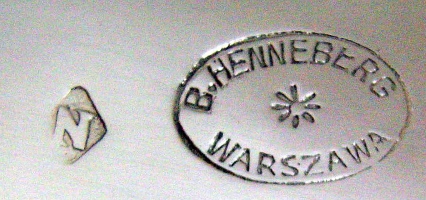

A fake mark, containing a 8-ray star instead of the correct 7-ray star. This mistake is combined with the non-uniform size of the letters used for the inscriptions inside the oval.
|
|
39
|
after 1883

A fake mark with a non-symmetric 8-petal rosette, combined with an additional disc inside the rosette instead of an empty space. This fake mark is also characterised by the non-uniform size of the letters, used for inscriptions inside the oval. But the most shocking is the incorrect writing of the "HENNEBERG" word, namely, "HENNEBEG"(!).
|
|
40
|
after 1898




Finally, there was (and even now is!) a lot of forgeries referring to the high-quality silver deposition mark with the 6-pointed Star of David. Namely, the letter "G" in the word "HENNEBERG " is given without any tail (see above my comment for the Mark No.12). Such forgeries are rather popular nowadays (they are even often offered on the site www.allegro.pl) and used incidentally to fake the highly-priced pieces designed by Julia Keilowa. The letters inside the inscriptions "B.HENNEBERG" and "WARSZAWA", used in such fake marks, could be additionally non-uniform in size or very different from the original fonts. For example, cf. the incorrect shape of the "A" letter in the word"WARSZAWA" with too low position of the horizontal bar with the shape of the "A" letters inside the Mark No.12, presented above.
|

|
A fragment of the title page of Bros. Henneberg Catalogue, issued in c.1894 (in Russian and Polish).
|
References.
[1] David N. Nikogosyan, Marks of Silver-Plated Items Produced by Warsaw Factories in Russian Empire. Antiques, Art and Collectables, N° 7 - 8 (No.98), pp.74 - 93 (2012) [in Russian].
[2] Maria Ejchman, Platery. Katalog Zbioru Platerow Warsawikich im, Anieli i Tadeusza Wysuadeckich (Warszawa: Museum Woli, 2005) p.83 [in Polish]. English translation of the title: Warsaw Silver Plate. Catalogue of the collection, gathered by Aniela and Tadeusz Wysiadecki.
[3] David N. Nikogosyan, "Christofle: History and Marks", Silver Magazine, vol.44, No.1, pp.28-35 (2012)
David N. Nikogosyan and Joanna Paprocka-Gajek
- 2018 -
|
|









































































































































































